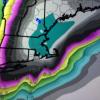All Activity
- Past hour
-

2025-2026 ENSO
40/70 Benchmark replied to 40/70 Benchmark's topic in Weather Forecasting and Discussion
You keep passing off these sweeping judgements, such as the "the long 30 year cycles have become a thing of the past" as if they are fact...they aren't. Its your opnion. Then if an index doesn't fit your agenda, you dismiss it and insert some alternate index. It doesn't work that way....I may consider the ONI archaic, but I still factor it in. I just include other metrics to more accurately depict modern ENSO phases. -

2025-2026 ENSO
40/70 Benchmark replied to 40/70 Benchmark's topic in Weather Forecasting and Discussion
I mean in the cold multidecadal phase, not locked into the cold phase, per se. I figured that was tacit. The variation happens in every multidecadal phase....there is alway some oscillation within the larger multidecadal phase. Its never literally in one state for 30 years, however, one phase is perdominant depending on the longer term, multidecadal trend. -
Already near 60
-
April rainfall (28th) site / actual (monthly avg) EWR: 2.39 (3.99) NYC: 3.25 (4.21) LGA: 2.84 (3.99) JFK: 2.17 ( 3.62) PHL: 2.83 (3.65)
-
Records: Highs: EWR: 90 (2009) NYC: 90 (2009) LGA: 89 (2009) JFK: 85 (2009) Lows: EWR: 33 (1934) NYC: 31 (1874) LGA: 36 (1947) JFK: 37 (1966) Historical: 1893: A half-mile wide estimated F4 tornado killed 23 people and injured 150 as it tore a path of devastation through Cisco, Texas. Every building in the town was either destroyed or severely damaged. 1921 - A severe hailstorm in Anson County, NC, produced hail the size of baseballs. Gardens, grain fields and trees were destroyed. Pine trees in the storm's path had to be cut for lumber because of the hail damage. (The Weather Channel) 1928 - A coastal storm produced tremendous late season snows in the Central Appalachians, including 35 inches at Bayard WV, 31 inches at Somerset PA, and 30 inches at Grantsville MD. High winds accompanying the heavy wet snow uprooted trees and unroofed a number of homes. The storm caused great damage to fruit trees and wild life. (David Ludlum) (The Weather Channel) 1973: The record crest of the Mississippi River at St. Louis, Missouri was registered at 43.23 feet on this day. This level exceeded the previous 1785 mark by 1.23 feet. This record was broken during the 1993 Flood when the Mississippi River crested at 49.58 feet on August 1st. At Memphis, Tennessee, the Mississippi was over flood stage for 63 days, more than that of the historic 1927 flood, and the river was above flood stage for an even longer 107 days at upstream Cairo, Illinois. Out of the seven largest floods on the Mississippi between 1927 and 1997, the 1973 event ranked third in both volume discharged and duration but only sixth in flood height. Over $250 million of damages were incurred mainly in the Mississippi Valley states of Missouri, Arkansas, Tennessee, Mississippi, and Louisiana. 1987 - Twenty cities in the western and central U.S. reported record high temperatures for the date. Highs of 95 degrees at Houston TX, 95 degrees at Lake Charles LA, and 94 degrees at Port Arthur TX, were April records. (The National Weather Summary) 1988 - Miami, FL, hit 92 degrees, marking a record eight days of 90 degree heat in the month of April. Squalls produced snow in the Washington D.C. area. Belvoir VA reported a temperature reading of 57 degrees at the time the snow began. (Storm Data) (The National Weather Summary) 1989 - Strong northerly winds and heavy snow ushered cold air into the north central U.S. Snowfall totals in Montana ranged up to 20 inches at Miles City. Thunderstorms produced severe weather from eastern Texas to the Southern Appalachians and the southern Ohio Valley. Hail four and a half inches in diameter was reported at Keller TX and White Settlement TX. (Storm Data) (The National Weather Summary) 1990 - Thunderstorms produced severe weather in the southeastern U.S. during the day. Severe thunderstorms spawned four tornadoes, including one which injured four persons at Inman SC. There were also more than one hundred reports of large hail and damaging winds, with better than half of those reports in Georgia. Strong thunderstorm winds injured four people at Sadler's Creek SC. (The National Weather Summary) (Storm Data) Twenty-nine cities in the northeastern U.S. reported record high temperatures for the date as readings soared into the 80s and lower 90s. Highs of 88 degrees at Binghamton NY, 94 degrees at Buffalo NY, 89 degrees at Erie PA, 90 degrees at Newark NJ, 93 degrees at Rochester NY and 92 degrees at Syracuse NY, were records for the month of April. (The National Weather Summary) 1991: Memphis, Tennessee recorded their wettest April ever with 15.03 inches, breaking their previous record of 13.90 inches in 1872. 2002: During the evening hours, a violent F4 tornado carved a 64-mile path across southeast Maryland. The La Plata, Maryland tornado was part of a larger severe weather outbreak that began in the mid-Mississippi Valley early on that day and spread across portions of the Ohio Valley and the Mid-Atlantic States. In Maryland, three deaths and 122 injuries were a direct result of the storm. Property damage exceeded $100 million. Tornadoes along the Atlantic coast are not frequent, and tornadoes of this magnitude are extremely rare. Only six F4 tornadoes have occurred farther north and east of the La Plata storm: Worchester, Massachusetts - 1953; New York/Massachusetts - 1973; Windsor Locks, Connecticut - 1979; five counties in New York - 1989; New Haven, Connecticut - 1989; North Egremont, Massachusetts - 1995. None was as close to the coast. The tornado traveled across the Chesapeake Bay almost to the Atlantic.
-
58 / 32 mostly sunny. Low - upper 70s today, near to low/mid 80s tomorrow (in the warm spots). Nice week on tap. Showers / storms potential later thursday night into Friday (0.15 - 0.50). The Weekend looks mainly dry once past Sat AM. Overnight forecast has trough nd cutoff more to the NE and keeps the areas near to above normal through the next 10 days (overall). Will see if subsequent data continue to shows the trough more to the NE.
-
I disagree with your assessment about a cold phase since 1998. The PDO has been shorter cycling than it was prior to the 1990s. So we have been getting alternating +PDO and -PDO cycles since then. This is why the 2010s into the 2020s have experienced such a rapid shift between the record +PDO in 2015 to record -PDO in the early 2020s. Those long 30 year cycles have become a thing of the past. Plus the rapid warming of the Western Pacific has altered the way the PDOs have been relating to our sensible weather. So canonical expectations based solely on PDO phase have not been working out. -PDOs of recent years have been much different from earlier -PDOs due to the 2nd EOF running so warm. So this has lead to much warmer and less snowy -PDOs then were experienced in the past. We also experienced record warmth with the +PDO in December 2015. So not seeing how another +PDO in coming years if it were to evolve would necessarily be any cooler than the recent -PDOs. The colder 13-14 into 14-15 period was more a result of the +TNH and +NPM pattern. But as we saw last winter, the stronger Northern Stream of the Pacific Jet muted that influence. So no cold trough was able to develop in Canada like we saw in 13-14. This is why when I saw the Pacific Jet and storm tracks last December I said early on that we weren’t going to see another 13-14 repeat like some on twitter were calling for.
-
There are other benefits to having drier conditions beyond simply lower humidity and lower levels of allergens. I've noticed in our wetter years we have much higher populations of pests like ticks and mosquitoes. They are much lower when it's hot and dry. No doubt having a tropical rain forest like climate during the warm season will increase the risk of infectious diseases as not only are these pest vectors more common it's been proven that bacteria are more infectious in warm humid conditions than they are in drier hotter weather because they can be airborne for longer time periods when it's warm and humid as opposed to hot and dry (the opposite is true of viruses which spend more time airborne in cold and dry conditions, part of the reason why the flu virus and other viruses were so bad last winter.)
-
I believe that there are a number of factors that affect soil moisture. Soil type would be a key factor, as would depth to bedrock I would think.
-
what map is that?
-
Dews in the 50s for the first time this year. Approaching line of storms. We are back.
-
See Euro/ EPS.. Toss GFS. And it was over . No lore frosts / freezes and hasn’t been for weeks now
-
Damn. Clarksville mesonet hit 33! Most of the states mesonet stations were actually in the 30s for lows.
-
Didnt you say this last week? I have feeling you grew the wrong plants this year..
-
Was a super chilly start but climbing nicely, even from like 90 minutes ago.
-
Low of 41. Respectable for end of April.
-
nwohweather started following 4/28 and 4/29 Severe Weather
-
I gotta imagine this mornings line will put a nice boundary down for MN/IA
-
Hopefully the gfs is wrong early next week.
-
No frost here (I rarely get a frost, wind blows thru a 'gap' even in calmest air here at the house) but seen plenty around when out earlier this morning. Low was 36.8, currently 38.4/34.0 at 7:45 am. Edit- went back and looked, record is 30 degrees for date set in 1993 and 2000.
- Today
-
It over . Get the tomatoes in
-
Enhanced risk tomorrow, pretty unusual around here. Looks more relevant to the north of PIT.
-
Should be
-

2025-2026 ENSO
40/70 Benchmark replied to 40/70 Benchmark's topic in Weather Forecasting and Discussion
I didn't say that. Its too early....I haven't started on next winter yet. I was just making a point. -

2025-2026 ENSO
40/70 Benchmark replied to 40/70 Benchmark's topic in Weather Forecasting and Discussion
Right...and many think its too early to be discussing some of the longer term shifts that you dicuss, yet here we are. I still believe that its more likely that the Pacific is switching phases, given than the current cold phase began in 1998, than it is that we have crossed some crucial "tipping point" threshold with respect to CC. Keep in mind that I am not discounting the latter as a viable possibility, either. And just because I feel that the change may be underway doesn't mean I expect a 2.00+ seasonally PDO next winter, either. -
No, just can't seem to get away from it.

















